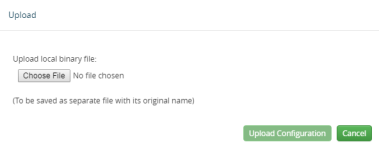Work with Configuration Files in the Configurations Page
GigaVUE‑OS provides the ability to save and restore configuration files including all of the settings in place on the system at any time.
To work with configuration files, use the options available when you select Settings > Config and Licenses > Configurations, which displays the Configuration Files page shown in Figure 1.

|
Figure 31
|
Configuration Files Page |
The following sections describe how to set the options:
Configuration File Options
The Configuration Files page lists the configuration files currently saved on the node. The last booted configuration file is listed with Yes in the Active column. From here, you can perform the following tasks when you select a configuration file:
|
■
|
Click Switch To Active to load the selected configuration file, applying its settings. |
|
■
|
Click Delete to remove the selected file from the system. |
|
■
|
Click Download to download the file to your local environment. |
|
■
|
Click Action to select various operations to perform on the files. For details, refer to Configuration Actions. |
Configuration Actions
The active configuration is the combination of the last booted configuration file and all unsaved commands that led to the current running configuration. On the Configuration page, you can perform the following tasks with the Actions menu:
|
■
|
Click Action > Save to save the running configuration to the active configuration file (the one listed in bold in the Configuration Files table, above). |
|
■
|
Click Action > Revert to discard the running configuration and apply the contents of the active configuration file. |
|
■
|
Click Action > Save As to save the running configuration to a new file and make it active. Use the adjacent field to provide a name for the new configuration file. |
Upload a Configuration
Use the Upload Configuration options to send configuration files from the local system to the GigaVUE node. To upload a configuration file, do the following:
|
1.
|
Select Actions > Upload. The Upload dialog displays as follows: |

|
2.
|
On the Upload Dialog, click Choose File to upload the binary file. |
|
3.
|
After the file is uploaded, click Upload Configuration. |
The file is saved on the GigaVUE node with its original name. This is handy when you've saved some standard configuration files to your system using the Save command in the Configuration Files section above.
Import a Configuration
To retrieve a saved configuration file from a remote host, using HTTP, HTTPS, SCP, SFTP, FTP, or TFTP, do the following:
|
1.
|
Select the Action > Import. The Import Configuration Files page displays. |
|
2.
|
Select the Protocol to use, which is one of the following: HTTP, HTTPS, SCP, SFTP, FTP, or TFTP. |
|
3.
|
Supply the IP address or hostname of the remote host in the Hostname or IP Address field. |
|
4.
|
Provide the credentials used to log in to the system by entering the user name in the Remote Username field and the user’s password in the Remote Password field. |
|
5.
|
In the File Path field, provide the filename and filename path on the remote system. |





